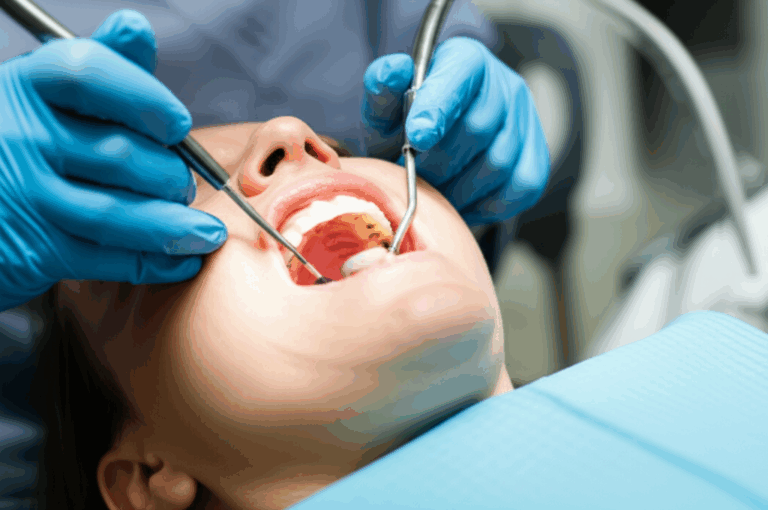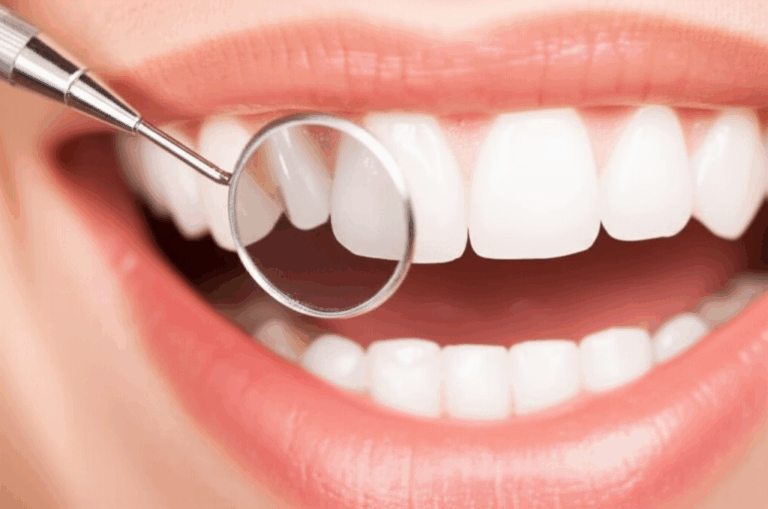
What a Dental Implant Looks Like Before the Crown: A Visual Guide to the Healing Stages
Dental implants have changed the way we fix missing teeth. Still, many people get nervous or curious about what their mouth will look like before the beautiful crown is put in place. This article will walk you through each stage of a dental implant, show you what to expect, and help calm your worries. If you want to know, “What does a dental implant look like before the crown?”—you’re in the right place!
Table of Contents
What is a Dental Implant, and Why Choose One?
A dental implant is a special way to replace a missing tooth so you can chew, smile, and talk easily. The implant is a small titanium screw that goes inside your jawbone. Over time, your bone grows around it in a step called osseointegration.
Why do so many people choose dental implants? They’re strong, look real, and often last for many years—sometimes your whole life! Unlike dentures, implants don’t move around when you talk or eat. If you’re wondering how dental implants compare to other ways to replace teeth, check out this helpful guide on dental implant alternatives.
Why Should You Care About the Way Your Implant Looks Before the Crown?
Maybe you’re getting an implant soon, or maybe the dentist already put in the post. At this time, you might be thinking: “Will people see metal in my mouth?” or “Is this bump normal?”
You probably care about how your smile will look while you heal—and that’s normal! Seeing a silver cap or a little post in your gums might surprise you. I’m here to help you know what’s usual so you don’t worry. Remember, this “weird-looking” stage doesn’t last long. Soon, a nice new tooth will cover it all up.
What Happens Right After the Implant is Placed?
Let’s picture the first day after your implant surgery. The dentist puts a titanium post into your jawbone where the tooth root was. Usually, this post—sometimes called the implant screw—is below the gum line. Sometimes, the dentist covers the whole implant with gum, other times a little part sticks out.
What might you see or feel?
- Stitches closing the gum over or around the implant.
- Some swelling and maybe a bit of bruising on your gums or cheek. This looks a bit puffy but goes away after a few days.
- Some bleeding if you look right after surgery, but it stops soon.
You won’t see the whole implant post, just maybe a little bump or, if you look closely, a tiny metal dot through the gum. This is a tender time and your body needs to heal.
What is Osseointegration, and Why is it Important?
Let’s keep the science easy! Osseointegration is the main thing that makes an implant work. It means your bone is growing around the titanium post and holding it tight.
Why’s this matter? Without good bone growth, your implant won’t last. This step usually takes three to six months, depending on how healthy your bone is. The top jaw sometimes takes longer than the bottom, since the bone is softer.
You won’t see the bone growing, but your dentist will check how you’re healing. They might take X-rays in the office to see how things look.
What is a Healing Cap (Healing Abutment), and What Does it Look Like?
Here’s the step lots of people ask about. After a week or more of healing, the dentist puts a healing cap—also called a healing abutment—on top of the implant post. Sometimes this is done during your first surgery, sometimes you come back for a quick, simple surgery to put it in.
What does it look like? Think of a small, round bump sticking up from your gum. It’s usually shiny silver or gray (because it’s made of titanium), but sometimes it’s tooth-colored. The healing abutment helps your gum shape itself in a round, natural way so it will fit tightly around the new crown.
There are a few sizes and shapes, but most healing caps look like a button or tiny post about the size of a pencil eraser.
Why do you need it? The healing cap protects the inside of your implant and helps your gum heal right. If you look in the mirror, you’ll see a small smooth bump. Most people may not even notice unless you show them.
What Happens to Your Gums Around the Implant?
While you heal, your gum tissue does something really helpful. It grows around the healing cap, kind of like a scarf wrapping a stick. Healthy gums should look pink, tight, and feel fine. Over time, the gum gets used to the new shape.
Sometimes things don’t go perfect. Things to look out for:
- Redness
- Pus or weird liquid
- Bad pain or swelling
These could mean you have peri-implantitis or an infection. If you see this, call your dentist right away. While you’re waiting for your crown, you should keep the area clean. Brush gently and maybe use a water flosser if your dentist says it’s okay.
For more advice on how to keep your gums healthy, you can read these tips from a leading china dental lab.
What is an Abutment, and How Does it Appear?
Next comes a step that makes your implant look more like a tooth: the abutment. The abutment joins the implant post to your soon-to-be crown.
It’s a tiny cylinder-shaped piece sticking a little above your gums. It’s often gray, silver, or tooth-colored. Abutments come in lots of sizes, depending on where you need them in your mouth. Your gum will close nicely around it.
When does this happen? Sometimes, the healing cap is switched out for the abutment. Sometimes, they use the same piece for both. After the abutment is put in, your gum keeps healing around it, getting ready for the new tooth.
Here’s a quick look at the pieces:
| Piece | What it Does | What it Looks Like |
|---|---|---|
| Implant Post | Replaces tooth root in jaw | Hidden, feels hard |
| Healing Cap | Shapes gum, protects implant | Small round/oval knob |
| Abutment | Holds the crown, connects implant | Short post, thin and tall |
What About Taking Impressions for Your Crown?
Before your dentist can put on your new tooth (the crown), they need to copy how your mouth looks. This is called taking impressions. Sometimes, the dentist uses a squishy material. Other times, they’ll use a digital scanner—kind of like waving a tiny camera in your mouth.
The impression is important because it helps the dental lab make a crown that fits just right on top of your abutment and looks like your other teeth. A good fit means more comfort and lasting results.
There are two kinds of abutments:
- Stock abutments—these come in regular shapes and sizes.
- Custom abutments—these are made just for your mouth.
Either way, you’ll just see a small post showing while you wait for your real crown.
How Will You Feel During These Stages?
Let’s be honest. Dental work can make anyone feel worried, especially when you’re in-between the steps. So, what should you expect?
Right after surgery: You might feel some pain, light swelling, and even a bit of soreness as your mouth gets better. Over-the-counter pain pills usually help, and your dentist might give you special instructions for cleaning.
During the healing cap or abutment step: You might feel the area is tender at first. Sometimes the healing cap or abutment feels a bit funny or even a little loose. That’s a good reason to see your dentist, just to be sure!
What about eating? At first, eat softer foods. No hard apples or sticky candy. After a few weeks, most people eat normal foods, just careful not to bite near the healing spot.
Is My Implant Healing Normally?
Sometimes you look and think, “Is this what it’s meant to look like?” That’s a common question! Here are signs that things are going fine:
- Gums look pink and healthy around the implant cap or abutment.
- You don’t feel bad pain—just a bit sore.
- There’s no bleeding, pus, or bad smell.
- Your dentist checks things and says you’re healing fine.
Things to watch for:
- Redness growing bigger than the implant area.
- Swelling getting worse, not better.
- Pain that stays, especially if it wakes you up at night.
- Caps that are super loose, or if you can twist them with your finger.
If anything worries you, call your dentist. They’ll want to see you and double-check everything is healing like it should.
FAQs About Dental Implants Before the Crown
Is it normal to see the healing cap?
Yes! It’s usually a small shiny bump on your gums. That’s normal.
Will my friends see the implant?
Most people won’t notice unless you point it out. Often, your lips or cheeks cover it when you talk or smile.
Can I eat with just the abutment or healing cap?
You can, but chew carefully and stay away from tough or sticky foods.
Will there be a gap?
Sometimes there’s a small space where the tooth will go, but it’s just for now. If it bothers you, ask your dentist about a temporary tooth or small denture.
How long until I get my crown?
It usually takes 3-6 months from the first surgery until your permanent crown goes in—sometimes less, sometimes more.
Key Points to Remember
- A dental implant is not just the crown—it’s the post, healing cap, abutment, and then the crown.
- The implant post is usually hidden under your gums.
- The healing cap is a small, round metal or tooth-colored button that helps your gum.
- The abutment connects the implant to your new tooth. It’s a tiny post that you see until your crown is ready.
- It’s normal for the healing cap or abutment to be seen while you wait for your crown.
- Keep the area clean, even if it feels weird.
- Eat soft food at first to keep your implant safe.
- Tell your dentist if you have pain, swelling, or if anything feels loose.
- The odd look is only for a short time! The final crown will look and feel just right.
Quick Final Tips
- Stay in touch with your dentist at every step.
- Brush and floss well—ask about water flossers for cleaning around healing caps.
- Be patient—the long-term reward is worth a few months of a funny look.
- Nervous about the process? You’re not alone! Most people feel this way before they see their new smile.
Smile bravely—your new tooth is coming soon!








